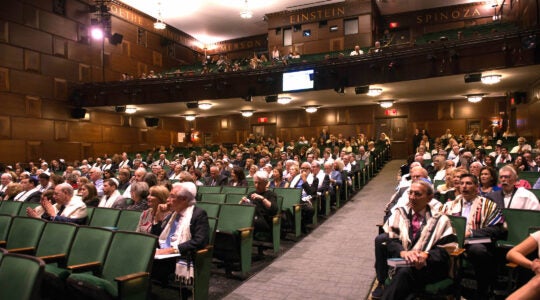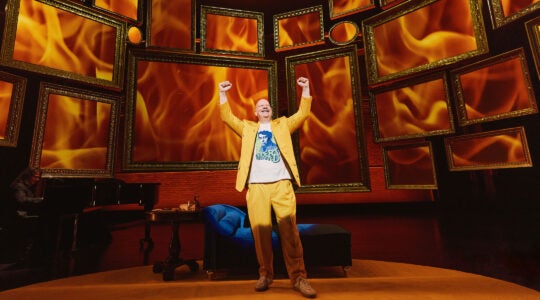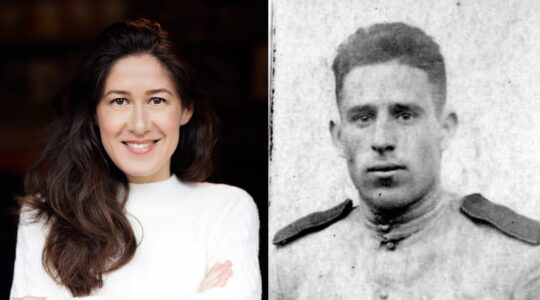Editor’s note: This is the first of a two-part series connected to the 90th anniversary of UJA-Federation of New York. The differences between the American Jewish community of the early 1900s and today’s American Jewry are vast and notable. Volumes have been written about the ethnic division that marked the earlier community, between the well-established, often wealthy German Jews, who began arriving in the 1840s and ‘50s, and the more than two million new arrivals from the shtetls of Eastern Europe, many of them mired in poverty and “Old World” ways.
Another gulf between now and then involves the comfort level of American Jews. While established in their own community, the Jewish leaders of yore were often barred from non-Jewish circles and feared a surge of anti-Semitism, a contrast to the comfort and well being of today’s Jewish population, whose greatest fear may be assimilation.
But in other ways, the two communities are quite comparable — a fact perhaps best typified over the past 90 years by UJA-Federation of New York.
The pioneers who launched the federation enterprise nine decades ago had a reverence for Jewish values, just as their successors have in today’s era. Both, for instance, have cherished the importance of community and, with it, the concept that all Jews are responsible for each other — that the needs of all Jews count. Those needs might have differed from one decade to the next, and even from one year to the next, but the vocabulary of community members — and, behind it, their heart and soul — has remained strikingly similar.
The differences between the two eras, as well as the parallels, have come to the fore in recent weeks as UJA-Federation celebrates its 90th anniversary. The occasion also affords the opportunity for many to look ahead to the challenges that UJA-Federation is bound to face and to what its leaders hope will be another century of success.
Year Of EventsThe anniversary-year observance kicked off in late April with the William Rosenwald Mission, a five-day tour of Israel named for a founder of the United Jewish Appeal. The mission drew more than 350 participants, many of whom never before visited the Jewish state.
The celebration will also include the May 30 re-dedication of UJA-Federation’s building on East 59th Street, a 53-year-old structure that has recently been renovated, and a 90th anniversary dinner, June 19, at the Waldorf-Astoria.
John Ruskay, CEO of UJA-Federation, sees the organization’s goal as creating a “caring community,” one that helps those in need, renews Jewish life and strengthens the sense of Jewish peoplehood. “If we’re able to create such Jewish communities, both in New York and beyond, I believe we’d be able to sustain the Jewish community, giving it new meaning and purpose,” Ruskay said in a recent interview.
Similar words have come from Morris W. Offit, the organization’s president, and Susan K. Stern, chairwoman of the board, both of whom participated in the Rosenwald Mission. The concept “is as subliminal as it is palpable,” Offit said, adding that, for him, it’s tied to religion, the centrality of Israel and a collective responsibility for fellow Jews.
Those words aren’t far from the language employed by Felix M. Warburg, the renowned banker who, in 1917, founded the Federation for the Support of Philanthropic Societies of New York City. Warburg, the organization’s first president, often spoke of the imperative to aid the poor, heal the sick, educate the young and build the Jewish community.
Acting with other prominent Jewish families, including the Schiffs, the Buttenwiesers and the Lehmans, Warburg launched the new organization to bring order and efficiency to the more than 3,600 local Jewish charities that existed at the time, each of which competed for funds. Twenty-four agencies signed the federation’s charter, among them hospitals, educational institutions, community centers and social service agencies.
In another bridge between now and 1917, more than half the charter agencies or their progeny, 13 in all, are still part of UJA-Federation’s network today. Among them are three hospitals — Montefiore Medical Center, the Mount Sinai Medical Center and Beth Israel Medical Center — the Educational Alliance, the 92nd Street Y, the Hebrew Free Loan Society and the Jewish Board of Family and Children’s Services.
Another common thread is the global nature of federation’s work. Like UJA-Federation today, Warburg’s organization aided Jews overseas, raising $5 million for European Jews through a war-relief campaign, and Jews in what was then Palestine, now Israel. The overseas work has only expanded through the years, as has the organization’s professionalism.
The network of agencies has also grown, today numbering 100 local organizations, nine national groups and two international agencies. The $2.2 million distributed by the fledgling organization in its first year of existence has increased to more than $145 million each year, distributed to agencies and other organizations locally, in Israel and around the world. The amount is even higher if you count the federation’s frequent emergency campaigns in response to crises, like 9/11, Hurricane Katrina and Israel’s war in Lebanon last summer.
Key MergerBut UJA-Federation would not be the organization it is today had it not been for the 1986 merger between the Federation of Jewish Philanthropies of New York, as Warburg’s entity was then called, and the United Jewish Appeal, the agency created in 1939 to respond to rising threats against Jews throughout the world.
The union took place 13 years after the federation and UJA merged their annual campaigns, a direct response to the Yom Kippur War, and brought together two distinctly different groups of leaders, recalled Stephen D. Solender, who assisted in the merger and later served as the executive vice president of UJA-Federation. Solender’s late father, Sanford, served as the executive vice president of the Federation of Jewish Philanthropies from 1970 to 1980.
Now a consultant to UJA-Federation, Solender noted how leaders of the two entities once debated terms like “overseas” and “domestic,” seeing themselves either as more committed Israel or more devoted to local concerns. “One of the big issues in those days was how much money would stay here and how much money would go overseas,” he said. But the wisdom of several “outstanding leaders” kept a balance, Solender added, and the issue has long since disappeared, with allocations today based solely on wherever the need may be greatest.
One figure who played a major role in the merger is Ernest W. Michel, the executive vice president of UJA for six years and, later, the co-executive of UJA-Federation for three years, a post he shared with Stephen Solender.
Michel, today a consultant to UJA-Federation and its longest-serving staff member, is also one of the many Holocaust survivors to receive the organization’s aid. A native of Germany, Michel, now 83, spent five years in Nazi death camps, including Auschwitz, before escaping on a death march near the end of World War II. He covered the Nuremberg war-crimes trials as a reporter for a German news agency and then headed to the United States, where he joined UJA as a speaker in 1946.
“I spoke about what happened to me,” recalled Michel, who traveled to such states as Montana, Utah, Wyoming and Idaho, each with a miniscule Jewish population. “And I talked about what needs to happen to keep those who survived on their feet.”
Family TraditionsThe history of UJA-Federation — and the scope of its accomplishments — is a source of pride to many of today’s leaders and a motivation for doing their best.
“I’m very conscious of being the heir of an organization with such an outstanding philanthropic history,” Ruskay said. Pacing around his office and, at times gazing out his sixth-story window, he recounted how the federation has “been there” for the Jewish community time and time again, starting with the hordes of immigrants who populated the Lower East Side and extending through the Holocaust, the creation of a Jewish state and the building of Israel.
“Looking to the future,” Ruskay continued, “UJA-Federation is creating a paradigm shift by working with local and overseas partners to build a stronger, more vibrant community, linking our constituencies around the globe and mobilizing volunteers to unleash the caring potential of this community. We have created major initiatives to fill the gaps where there are new needs; linked synagogues to our human-service structure to help people access care; fostered Jewish education and identity through innovative programs; and strengthened the infrastructure and leadership of our agencies.”
Perhaps no one is prouder of UJA-Federation’s history than leaders today who are directly related to the organization’s founders and past leaders.
Larry Buttenwieser, an attorney and the federation’s president from 1971 to 1974, counts several relatives on both sides of his family as among the organization’s creators and shapers. His maternal grandfather, Arthur Lehman, served as the federation’s second president, followed by Buttenwieser’s paternal grandfather, Joseph. Buttenwieser’s father, Benjamin, also served as president of the organizations, and a host of other relatives have been involved with the 92nd Street Y, where one of his four children, Jill Buttenwieser, is a board member.
“My parents made it plain to me that at least some of my [philanthropic] involvement had to be in the Jewish community,” said Larry Buttenwieser. Moreover, he added, their instructions came “as a moral imperative — not because it would get me a better seat at the table.” For his parents, as for himself, Buttenwieser believes, service to the Jewish community was part of the effort to ensure Jewish continuity.
The same values inspired Elizabeth R. Varet, a board member of UJA-Federation, like Buttenwieser, and a daughter of William Rosenwald, who headed UJA. Varet’s grandfather, Julius Rosenwald, was the co-founder of Sears, Roebuck and Company, and a major philanthropist, giving both to African-American causes and the Jewish community.
Discussing her father, Varet said he was driven by an empathy for people at risk — people who were suffering — “and a feeling of ‘there but for the grace of God go I.’ And he believed in acting on it.”
Varet is particularly proud that UJA-Federation’s latest mission, the major mission to Israel in April, was named for her father. She said she hopes his name — “and, more than that, his spirit” — will continue to inspire people.
Next week: A look at the work of the network of agencies.
The New York Jewish Week brings you the stories behind the headlines, keeping you connected to Jewish life in New York. Help sustain the reporting you trust by donating today.




